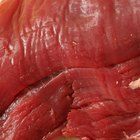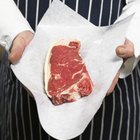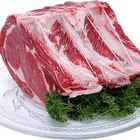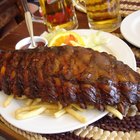bhofack2/iStock/GettyImages
Lamb that has not been trimmed properly may cook unevenly, cause flare-ups on the grill, and have inedible chunks of fat on the meat. After splurging on a choice cut of lamb, you want to deliver a winning dish to your family's table. Take some time to trim the fat off your lamb cuts before cooking.
Lamb Chops
The fat in lamb is not all bad. A quality cut of lamb should have white lines throughout the red meat. This is called marbling, and it keeps meat tender and flavorful when cooking, so you don’t want to get rid of all the fat. It’s the thick chunks of pure white found on the edges of your chops or around the bones that are unappetizing and cause problems when cooking. Put your chops on a cutting board and use a sharp knife to cut off large white chunks, getting as close to the red meat as possible.
Leg of Lamb
A large leg of lamb should have a lot of marbling, and will also have a thick layer of white on one side if the butcher has not trimmed it. Use a paper towel to grasp the edge of the fat layer and pull it up, then slice at the membrane that connects the fat and the meat, using the tip of a very sharp knife. Hold the knife horizontally to do this. If it’s sharp enough, you won’t have to put any strength behind it. As the blade tip skims the fat, it will peel right off. If small bits of membrane are left after you remove the big layer, you can slice them off carefully. A little fat is fine and keeps your meat moist, so it’s better to leave little remnants than to hack up the surface of your roast.
Lamb Ribs
Lamb ribs have a plastic-like membrane on the concave side, or the side where you can see the backs of the bones. This membrane acts like a shield that prevents flavors and heat from penetrating, so it’s got to go. Pry it up in one corner with a butter knife until you can grasp it with a paper towel, then peel it back. Flip your lamb ribs over and look for excessively thick white layers on the convex side. Grasp the fat at an edge and slice horizontally at it with the tip of a sharp knife, right between the meat and the fat. The less you disturb the actual meat, the better it will cook.
Frenching Procedure
Cleaning and preparing lamb for a crown roast is known as Frenching. Frenching lamb gives the finished roast the impressive crown-like appearance that makes diners “ooh” and “ahh” when it’s presented. Peel up the thick layer of fat covering the convex side of the bone. If you grab and tug firmly, it may peel right off. Use the tip of a knife to help it along if it's stubborn in some spots. Slice off the rubbery, fatty cartilage on the side of the roast. On the concave side of the roast, make a horizontal score across all the bones, about 2 to 3 inches above the tips, and repeat the score on the opposite side. Use your knife to finish by scraping off all the fat and meat from that score line to the tip of the bones, including in-between the bones.
Related Articles

How to Tell If a Pork Roast is Done

How to Cook a Restaurant-Quality Prime ...

How to Peel a Beef Tenderloin

Tenderloin Filet Vs. Top Sirloin
How to Butterfly a Steak to Cook Faster

How to Debone a Ribeye
How to Cook Tender Peeled Knuckle
How to Cook Buffalo Fillet

How to Cut Up Your Deer Tenderloins

How to Cook Half a Leg of Lamb

How to Grill a Boneless Leg of Lamb ...

How to Make Boar's Head Roast Beef at ...

How to Bake a Pork Loin Center Half

How to Cook Souvlaki in the Oven

How to Shave Eyebrow Lines

How to Cut Oxtail

Slow Roasting a Leg of Lamb Until It Is ...

How to Cook Prime Rib Bones in a Slow ...

How to Carve a Bottom Round Roast Into ...

How to Buy the Best Spare Ribs at the ...